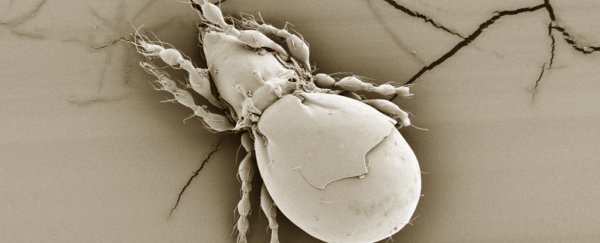This One Tiny Animal Has Found a Way to Give Up Sex Completely, And Still Do Fine

Oppiella nova up close. (M. Maraun and K.Wehne)
NATURE
MIKE MCRAE
25 SEPTEMBER 2021
Let's face it. Sex isn't always worth the effort. For many animals, the whole mating game is so inconvenient, going it alone and reproducing asexually is the best option.
As appealing as it might sound, however, evolution puts a heavy price on a population that gives up sex for too long. Sooner or later, a eukaryotic species will either need to swap chromosomes in a DNA shake-up that increases genetic variation, or risk fading into extinction.
That's the rule, at least – but the beetle mite (Oppiella nova) is having none of it.
By comparing its genome with that of its sexually active cousin, O. subpectinata, a team of researchers from across Europe has found that this micrometer-sized arthropod has been doing quite all right living a chaste lifestyle for... millions of years.
Like us, these tiny mites have a copy for every chromosome making up their genome, which makes them a diploid organism.
Swapping chromosomes and subjecting them to a bit of mix-and-match every now and then helps give a population a diverse choice in genetic combinations, meaning when catastrophe strikes – be it a plague, a temperature change, or introduction of a new predator – there's bound to be at least a few individuals that will cope.
Strip away all the bells and whistles, and that's sex all summed up. Unfortunately, those bells and whistles (searching out mates, competing with them, producing all that sperm, the whole pregnancy thing) impose a toll on maximizing genetic diversity.
There are other ways to maintain a degree of variation that don't rely on sexual reproduction. These processes cause mutations to build up differently in types of the same gene (or allele), creating a unique signature among the genes of asexual organisms.
Known as the Meselson effect, named after Harvard geneticist Matthew Meselson, this mutation pattern could in theory be used to identify a diploid organism as a bona fide, long-term asexual species.
The only problem is none of the evidence for this effect has been clear-cut, leaving too much room for doubt. Some ancient lineages of species thought to be asexual have since been found to have only recent converts, or – scandalous as it is to suggest – have peppered their genes with the occasional licentious tryst over the eons.
What researchers needed was a strong, unambiguous signal of variation in genes in an animal suspected of having given up sex long, long ago, and never looked back.
Which brings us back to O. nova – a little mite with sublineages that went their separate ways between 6 and 16 million years ago, suggesting it's a species that's been around for quite a while.
More importantly, it's a species known to be asexual, in contrast with others on its branch of the family tree, making it a prime specimen to study for evidence of the Meselson effect.
As one might imagine of an animal that could form a conga-line inside a single millimeter, the task of collecting them and analyzing their DNA wasn't exactly easy.
"These mites are only one-fifth of a millimeter in size and difficult to identify," says reproductive biologist Jens Bast from the University of Lausanne in Switzerland.
The team even required specialized computer programs to decipher the genomes, but it was all worth it in the end.
"Our results clearly show that O. nova reproduces exclusively asexually," says Bast.
"When it comes to understanding how evolution works without sex, these beetle mites could still provide a surprise or two."
This isn't to say asexual reproduction isn't without its problems. The beetle mite appears to be an exception to an otherwise fairly consistent rule in biology.
But the discovery of an animal that's managed to leave sex millions of years in the past does demonstrate it's possible to thrive without it.
This research was published in PNAS.
No comments:
Post a Comment